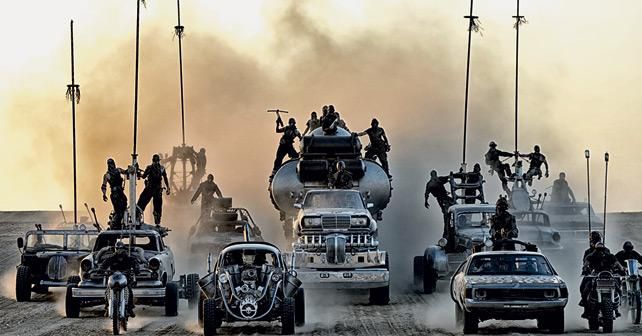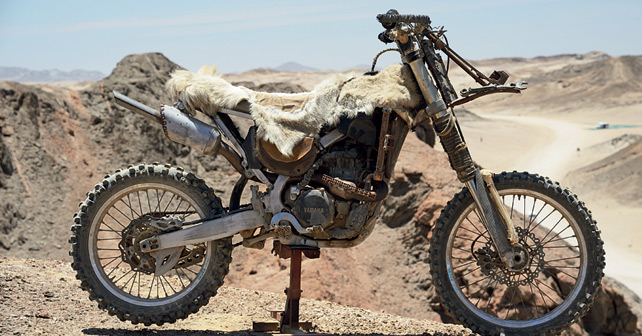
After 30 years, Max is back – the solitary hero who tries to resist the barbarity of a world that is slowly destroying itself. Fury Road is full of unbelievable and amazing vehicles that kick up a cloud of dust.
A lot of film directors have dedicated themselves to depicting the future, usually with disturbing results. Some visions have been more successful than others – a few have been so successful that they’ve become common heritage and collective vision. Among these, the best known is the ‘cyberpunk’ style Blade Runner – at the base of which is the idea of a deep (punk) social decay despite strong (cyber) technological development. But there’s also ‘steampunk,’ in which humanity comes back to life with the technologies of the 19th century and its ‘steam’ engines. And then there’s a third variant, with no official name, but you could refer to it as ‘gaspunk,’ in which society collapses and technology goes back to the first half of the 20th century where the combustion engine take centre stage – and petrol (gasoline) becomes the most precious element!
EVERYTHING STARTS WITH GASOLINE
This vision is the result of the imagination of George Miller – the creative director, who in the late 1970s invented and set the cycle of Mad Max in motion. Beyond the popularity of the movie at the box office, what’s noteworthy is that 30 years later (a series of three movies have appeared in 1979, 1981 and 1985) the type of doomsday scenario envisioned by Miller – especially with the second and third movies – has firmly entered into the collective imagination. Justice being the law of retaliation and a humanity organised in tribes, which moves almost in a nomadic way, driving cut-up old muscle cars of the fifties and sixties, welded and prepared as best as possible in those times. The same holds true for motorcycles as well. The bikers, who hold sway in the first movie, progressively lose their importance in the two sequels that follow – where it’s primarily the cars that dominate.
In Mad Max Fury Road, the bikes finally regain space. Certainly, here, as always, the film features everything from cars to trucks and sidecars, while the bikes are mostly used by the two central groups – the all-female tribe of Vuvalini, riding old modified tourers, and the Rock Raiders, a gang that raids the desert and rides on agile trial enduros to suddenly attack passing caravans.
Yamaha XT 660 with trailer (Vuvalini)
Yamaha R1 with lengthened swing arm (Vuvalini and Max)
Honda GL 1200 Gold Wing (Vuvalini)
NEW MAX, SAME OLD PROBLEMS
In this version of Mad Max, the director doesn’t change but the protagonist does. The handsome Tom Hardy picks up the difficult legacy of Mel Gibson, and his new challenge is to lead the desert Queen – Furiosa (Charlize Theron) – to freedom as they flee from the villain Immortan Joe. The film focuses, as always, on great visual impact and tight action – as it contains both the element of continuity and change.
As the film hit cinemas, we got the chance to speak with the production designer, Colin Gibson – the right hand man of the director and manager of the visual appearance of the film. Given the long gestation (the idea of ??the film was born in 2000), Colin could spend years thinking about the aspect of places and people – choosing, in the end, Namibian landscapes and outlandish vehicles, created without too many special effects, but with imagination, improvisation and a lot of workshop equipment.
The vehicles of the film can be divided roughly into three categories – those of the army to defend the Citadel (sports bikes or modified enduros), those of the Vuvalini (modified cruisers), a tribe of women warriors, and those of the gang of the Rock Raiders (modified enduros). It’s not common to start with motorcycles for a desert ride, and the modifications don’t really seem to help. But the visual impact is everything – on the silver screen, this is the most important aspect. Here is a short review of the bikes used in the film:
Colin, it seems that there’s a strong continuity with the first film shot in 1977...
You’re completely right – we took the first film as our starting point. Now, we’re 30 years in the future, but these are 30 years of a free-fall towards a new kind of feudalism. We thought that if you go to war in a place like this, you want good old steel and not some carbon fibre. You want something that works without computers, electronics, and stuff like that. And then there’s just the beauty of the cars of the fifties and sixties, which is unparalleled. I cannot even imagine a Toyota Corolla sawn into pieces and then reassembled together. I simply cannot imagine that…
2007 Yamaha YZF-R1 with extended swing arm (Gastown Armada)
2009 Yamaha YZ 450F (Rock Raiders)
Yamaha XT660 Ténéré with extended swing arm (Rock Raiders)
Gas Gas300 (Rock Raiders)

…And what’s the concept behind the vehicles here?
The vehicles are characters in the film, and, as all the other characters, they also have the task of making credible the world they live in. They had to adapt to the climate and soil of adversity, and this has created many difficulties. They were made while trying to identify what people do in a war – collect scrap, assemble, arm, raise troops, and go to battle.
The bikes seem to be much more recent – big Japanese cruisers and naked enduros with dragster style swing arms, as is fashionable in America, and even a trial bike.
Tell us a bit about the genesis of the vehicles in the film.
The bikes are an essential element, because they are like punctuations in the film – they alter the speed of the action in the movie. One of the loose cannons of Fury Road, the Rock Raiders – they are basically a pack of motorised hyenas – who attack convoys by moving almost vertically on rocky terrain. We had to adapt not only enduro bikes, but also trial bikes in order to make them capable of this kind of ‘unnatural’ action.
Some scenes from ‘Fury Road,’ a film whose “impact” is huge. But to define it merely as an “impact movie” is perhaps a bit simplistic. Also notable is the cast, which includes Tom Hardy, Oscar winner Charlize Theron, Nicholas Hoult, Hugh Keays-Byrne, Nathan Jones, Josh Helman, and Megan Gale.
So, there’s importance on both – the aesthetics and the technical aspect?
Absolutely correct. Just think about the motorcycle used by the Vuvalini – they were born to be ridden by nomadic ladies with the interpretation of a Harley-Davidson or a BMW, modified accordingly. These heavy touring bikes are certainly not designed to achieve high speeds on sand dunes, but our mechanics and the stunt coordinator Guy Norris did a fantastic job in making them able to really do what we designers had only imagined they could do.
And what about Max’s Ford Interceptor?
It’s the icon of the series. It’s the one that opens the film – it literally is the last beat of a Lost Legend. But then the baton changes hands. We entrust the pale light of the myth to the new Max, and we make a clean sweep of the Interceptor... only to find it again, sacked and rebuilt, as all that is part of this world now, even more powerful and more threatening than before.
Two intense moments for Tom Hardy / Mad Max, with and without the R1 (which must be a pleasure to ride on the sand). On the right is production designer, Colin Gibson.
The thing that’s made the fortune of Mad Max is just the power of the scenario, the visual impact of the ‘world’ we’re talking about right now. What’s the secret?
I like to use the concept of jazz. When you work with the post-apocalyptic, you work with a scenario that was mortally wounded by a lot of low rank films. It’s not enough to twist a bit ‘of wire around a hood to show the future of civilisation! The reality is stranger, it’s like jazz – a messed up instrument that plays somewhere, but it reminds you of the tune you had in mind before even listening to it. This is what the characters in our film do – they know that there’s been a beauty before and that now that beauty and harmony is lost. They try to recover whatever they can. There is an ethic in all of this, there is a logic – humanity fighting against the hostility of the elements and against itself. And this is basically the story of human beings, isn’t it?
© Riproduzione riservata




























Write your Comment